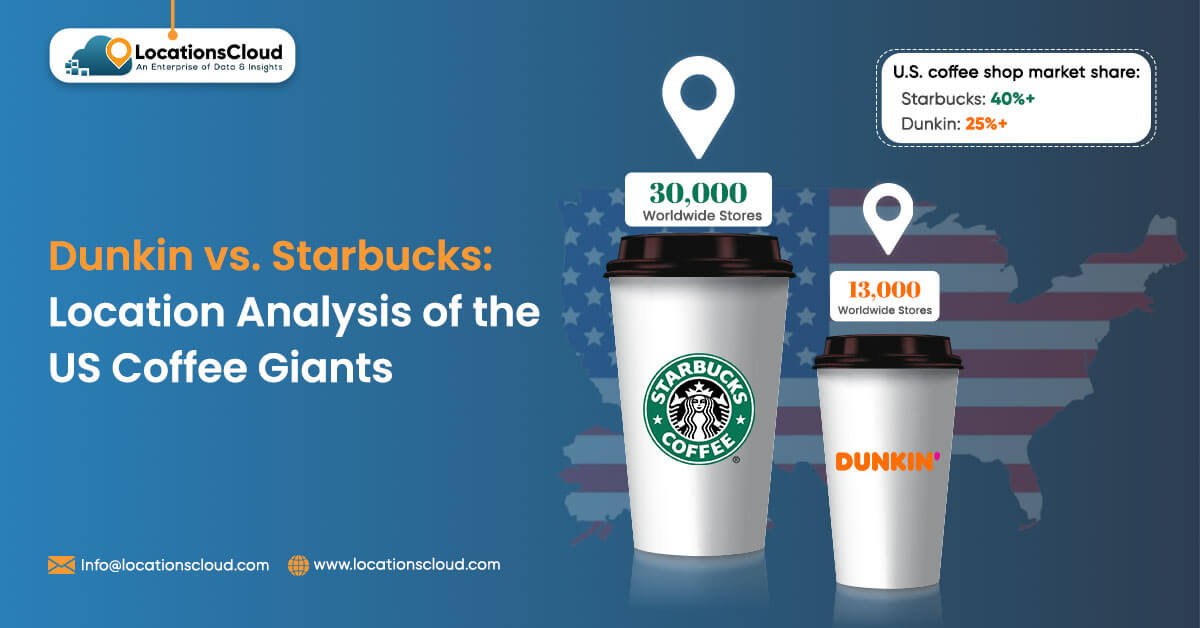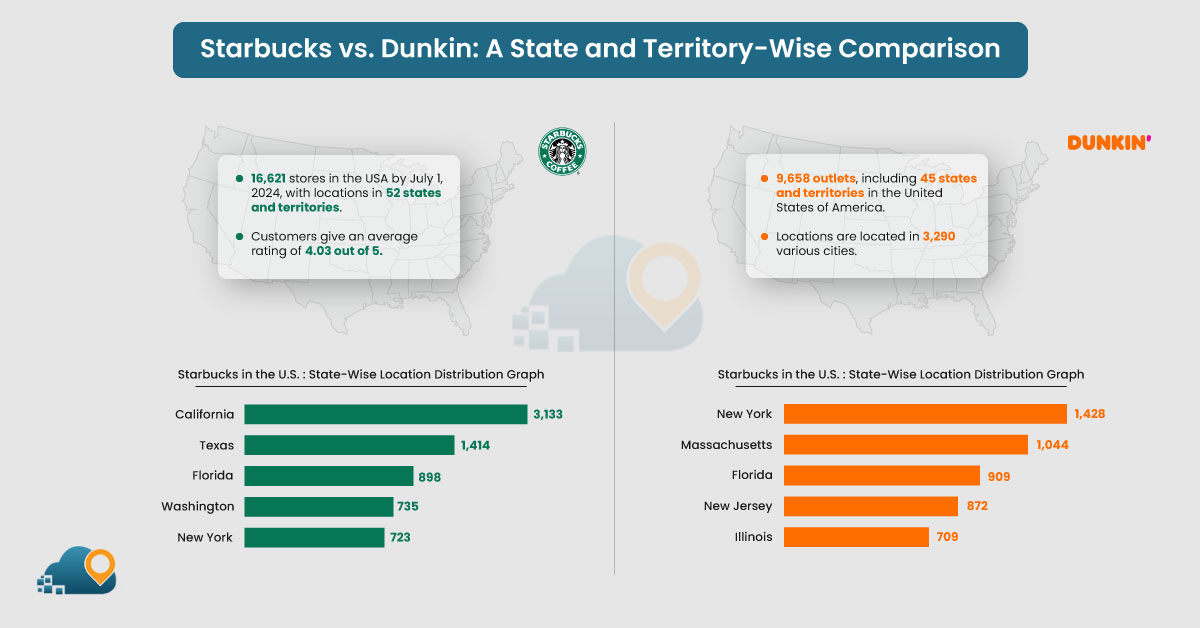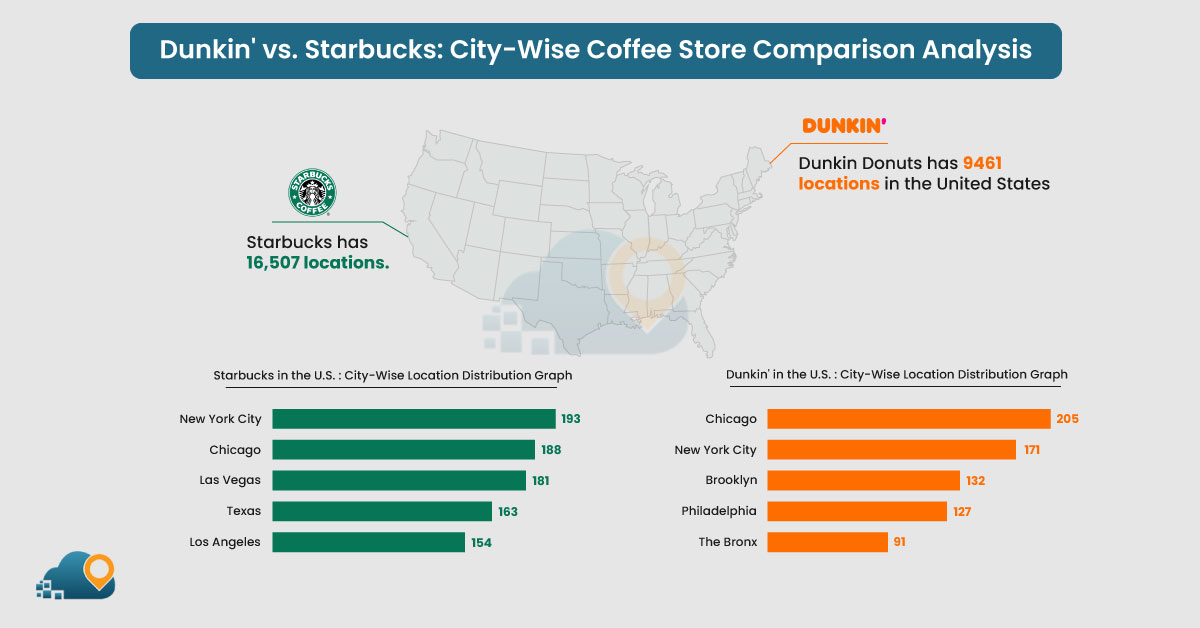
Starbucks and Dunkin are the two most popular and most prominent chain restaurants. They focus mainly on coffee drinks. While their drinks are similar, they offer different kinds of foods and have other business strategies. Dunkin Donuts was founded 20 years before Starbucks, but the latter has expanded faster and is far more significant. For the fiscal year ending in 2020, Starbucks recorded over $23. The revenue for Starbucks was $5 billion within the same year, and for Dunkin Brands, it was $1 billion. It generated $3 billion in 2019 and was later acquired by Inspire Brands in 2020.
Although both firms are similar in many respects, they differ in some aspects of operations and strategic management, such as the size of the company, store ownership, and branding policies. Starbucks, compared to Dunkin Brands, operates in more locations. Starbucks has over 30,000 stores worldwide, while Dunkin Brands has 13,000 worldwide. Dunkin Donuts brand has approximately 9658 stores across the United States as of the 30th of April, 2024. As of July 01, 2024, the Starbucks runs 16,621 stores in the United States, in 52 states and territories, that customers from 3,663 cities visit.
Starbucks has gone international more aggressively. Dunkin Brands has significant exposure in the global markets, and most of its locations are Baskin-Robbins ice cream stores rather than Dunkin Donuts outlets. International sales are a minor portion of Dunkin Donuts’ total sales figures compared to Starbucks, which has over 26% of its revenues from International operations. Dunkin has laid out its plans for international and domestic expansion over the coming years to closely compete with its main competitor, Starbucks. The difference in scale is attributed to the difference in the approach both companies took towards expansion.
Understanding the History of Dunkin and Starbucks
Dunkin
Dunkin Launch, formerly known as Dunkin Donuts, is a renowned American multinational food chain that majors in Coffee and donuts, apart from being a fast food chain. Founded by Bill Rosenberg in the 1950s in Quincy, Massachusetts, the chain has expanded dramatically over the years. In 1990, Dunkin Donuts became part of Allied Lyons Company, the parent company of Arctic Beverages, the original company to market Dunkin Donuts in North America. This led to the acquisition of the Mister Donut chain by Allied Lyons and changing it to Dunkin Donuts outlets.
By 2004, Dunkin and Baskin-Robbins had joined under Dunkin Brands, its headquarters in Canton, Massachusetts. It is pertinent to mention that in December 2020, Inspire Brand purchased Dunkin Brands, which operates Baskin Robbins, Dunkin Donuts, etc. The rebranding was initiated in the United States to analyze its international markets for this change in January 2019. The company removed the word ‘Donuts’ from its name but started being identified as Dunkin, a beverage company.
Starbucks
Starbucks Corporation is an American multinational coffeehouse and roastery reserve company located in Seattle, Washington. It specializes in food service and sells coffee. Established in 1971, Starbucks Corporation is the largest coffeehouse company.
By November 2022, there were 35,711 Starbucks Stores in 80 countries, 16,621 of which were in the United States. Over 8,900 stores in the United States are company-operated, though the others are licensed.
Starbucks is recognized as the leader of the second wave of coffee and the initiator of a new range of coffee experiences. Coffee is provided as hot and cold beverages, whole beans, micro-ground instant coffee, espresso, caffe latte, and tea. Starbucks also provides juices, Frappuccino, cake, and snacks; some are available for a limited time or can differ from country to country. Almost all stores examined also offered free Wi-Fi, although their availability differed from country to country.
What are the Major differences between Dunkin vs. Starbucks?
Dunkin and Starbucks are traditional coffee-focused chains in the United States and can be considered competitors. The two companies direct their food outlets to a similar client base, mainly serving coffee products, pastries, and breakfast and snack foods; however, each has established its own niche market.
A report of the IBIS World Report shows that two firms, namely, Starbucks and Dunkin, dominate the coffee shop industry in the United States based on relative location outlets. Starbucks, with its slightly higher-end atmosphere and more extensive variety menu selection, is generally more attractive to customers seeking a superior coffee experience. On the other hand, Dunkin dominates the typical cups of coffee by focusing on the product’s affordability and ease of access.
Top 5 States and Territories with the most Dunkin Donuts and Starbucks Locations
According to the data, Starbucks had 16,621 stores in the USA by July 1, 2024, with locations in 52 states and territories. This means that Starbucks operates in almost all the states and U.S. territories. Customers give their experience an average rating of 4.03 out of 5, showing that sentiments regarding the brand were generally positive.
Dunkin ‘Donuts has 9,658 outlets, including 45 states and territories in the United States of America. These locations are located in 3,290 various cities. This means that Dunkin’ Donuts has a coverage spread in most parts of its country, with stores located in thousands of cities and towns, making it easily reachable by many people.
Dunkin Donuts State-Wise Location Analysis
New York has 1,428 Dunkin’ Donuts locations, which accounts for 15% of the total number of Dunkin’ Donuts outlets in the United States. Its population is 19. 45 million.
This means that New York has one Dunkin’ Donuts shop per capita for every 13,620 citizens.
Massachusetts has 1044 Dunkin’ Donuts locations, accounting for only 11% of the total outlets. The total population of Massachusetts is 6. 89 million. Thus, the brand presence density is relatively high, with one Dunkin’ Donuts store per 6,600 individuals. This is the state with the highest density of Dunkin’ Donuts locations out of the mentioned states.
In Florida, there are 909 current Dunkin Donuts which is only 9% from total stores and having a total population of 21. 48 million. This means the firm has one Dunkin’ Donuts store for every 23,630 people. Compared to the other states mentioned above, Florida has the most spread-out locations.
New Jersey has 872 Dunkin’ Donuts shops, which accounts for 9% of the total number of restaurants in the United States. Its population is 8. 88 million. Currently, for every 10,190 people in New Jersey, there is exactly one Dunkin’ Donuts, which is comparable to New York.
Illinois has 709 Dunkin’ Donuts stores, 7% of total coverage. Currently, the population of Illinois is 12. 67 million. This means that there is one Dunkin’ Donuts store for every 17,870 people in Illinois, suggesting that the stores are not as concentrated as in states such as Massachusetts and New Jersey.
Starbucks State-Wise Location Analysis

California has the highest number of stores, with 3,133 locations, which is 19% of all Starbucks stores in the United States. For a country with a population of more than 39 million, adequate floor space for a Starbucks outlet is provided for every 12,612 citizens.
Texas has 1,414 Starbucks stores, approximately 9% of all Starbucks stores in the United States. There are Starbucks users for every 20,506 people in the state, with a total population of approximately 29 million.
Florida has 898 Starbucks, which accounts for 5% of all Starbucks in the United States or 21 million people. This means that the firm now has an outlet density of 41,919 people per outlet, significantly better than the industry’s ratio of 23,918 people per outlet.
Washington has 735 Starbucks outlets, More than 4% of the Starbucks stores in the United States, and the population estimate in Washington is 7. 62 million people for one store for 10360 persons.
New York has 723 outlets for the Starbucks organization in the United States, which is 4 % of the total. It has a population of about 19. This provides a ratio of one store per 26 910 people, meaning that the total number of stores is 45 million.
City Wise Coffee Store Distribution of Dunkin vs. Starbucks

Below are top 5 city-wise locations for Dunkin Donuts and Starbucks stores in the USA
Dunkin
Chicago is recognized as the city with the most Dunkin Donuts stores, with 205 locations. This high number indicates that the Dunkin’ brand performs extra well in Chicago, which can be expected due to its high popularity and large population.
New York City is ranked second, with 171 Dunkin Donuts shops in its field. This is attributed to the brand’s colossal operation base, established in one of the country’s most populous and busiest commercial hubs.
Brooklyn has 132 stores and is third among the boroughs of New York City. The bar chart shows that Brooklyn has a significantly higher number of stores, thus proving people’s preference for Dunkin and its availability to the inhabitants of this heavily populated borough.
Philadelphia is fourth with 127 stores. Philadelphia is another crucial market characterized by a high population density and an active nighttime economy, which form part of the United States’ cultural and business histories.
The Bronx, an additional borough of New York City, has only 91 stores. This goes a long way in underlining Dunkin Donuts’ long-term goals of catering for New York City’s boroughs to cater to the people’s needs.
Starbucks
New York City was ranked first with 193 Starbucks stores. This indicates Starbucks’s appreciation of a city that offers its market around the clock, with groups of consumers including travelers, workers, tourists, residents, and others. The large number of stores also points to New York’s heterogeneous neighborhoods, all of which Starbucks adapts to by serving different coffee cultures.
Chicago is ranked second with 188 stores. Thus, due to its high GDP, active business districts, vibrant artistic center, and extensive transportation networks, Chicago is one of the largest cities in the United States, which provides the basis for Starbucks’s successful existence. Chicago also has long winters, which can explain why people consume many warm products, such as warm beverages.
Las Vegas has registered 181 Starbucks outlets, although it has a smaller population density than many other cities on the list above. This could be because Las Vegas attracts millions of tourists, and people perhaps do not wish to wait for an exotic coffee while sightseeing or gambling.
Houston, Texas is the largest state in this regard, with 163 stores, of which Houston is the most prominent. Houston is a large city with large and diverse populations and a growing economy, meaning that there are lots of opportunities for Starbucks to locate and expand its stores in many different neighborhoods and business areas.
The metropolitan area of Los Angeles has 154 Starbucks stores, which indicates the significant role of this megacity as a cultural and economic center. Another reason is the large base of customers in Los Angeles, where Starbucks can attract everyone because the population is very diverse, the city itself is very large, and there is always a chance to appeal to coffee lovers. It is asserted that the improved target audience for the brand here is the people from the office, tourists, and the creative class.
States and Territories without any Dunkin and Starbucks Locations
In the United States, there are four states and territories where Starbucks has no presence: Guam, the United States of Virgin Islands, the Northern Mariana Islands, and the American Samoa. This could be due to low population density, geographical access, or some other factors that can make the company’s access to the outlets in those regions a problem. These territories are in places like the Pacific Islands and the Caribbean, which can make it challenging to run a coffee chain across the globe in such parts of the globe.
Although there is a Dunkin Donuts outlet in all 50 states of America, there are still 11 states and 5 territories with no Dunkin Donuts. The ten states under IAKA include Idaho, Puerto Rico, South Dakota, American Samoa, Washington State, Oregon, Guam Montana the US Virgin Islands the northern marina island and North Dakota. Demand, population, or distribution constabulary forces could be the reason of not having Dunkin Donuts store in such areas.
Local cultures regarding coffee and other existing Dunkin Donuts competitors in states like Washington and Oregon can influence the strategies Dunkin Donuts might use to introduce their products and services. Further, there are no Dunkin Donuts selling point on the mainland as in Idaho, South Dakota, Montana and North Dakota, among others.
Conclusion
Starbucks controls more company-operated cafes than Dunkin, some of which are franchise outlets. Although different in brand image and pricing strategy, both players have successfully grown their outlets throughout the country and occupy almost all major coffee shop markets in the U.S.
There is fierce competition not only in coffee. However, both brands have rolled out aggressive strategies to add food to their portfolios, mobile apps, and more rewarding membership programs to attract more consumers. This has been an effective competition that has helped shape the industry, and the chains continuously try to come up with new ways and ideas of expanding and taking as much market share as possible from the other.


